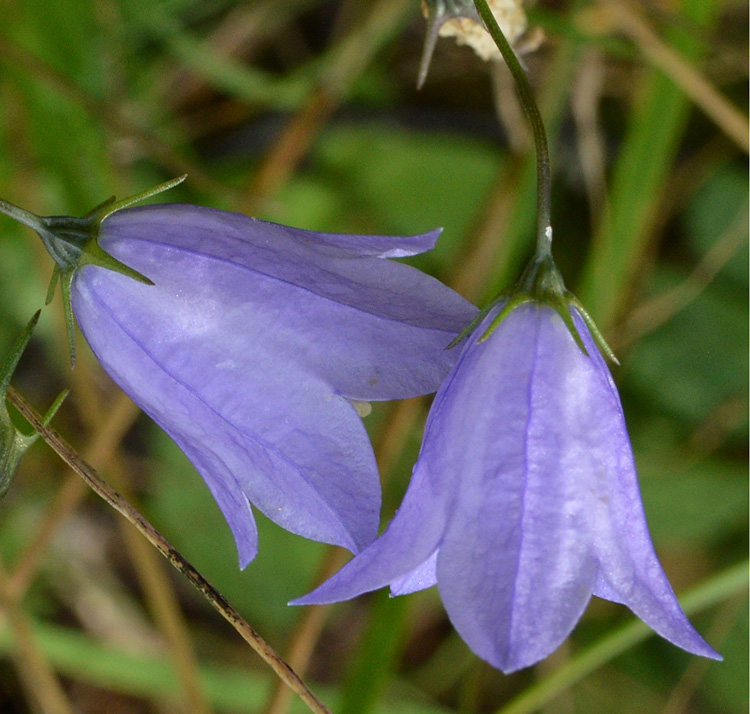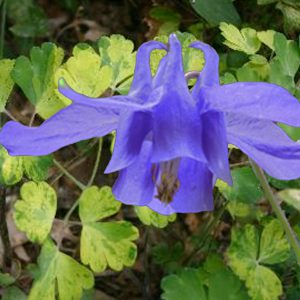- 1-9 pkts $4.50
- 10 pkts FREE
- Express post $12
Campanula rotundifolia
SCOTTISH HAREBELLS
Campanula rotundifolia, commonly known as Scottish Harebells or Scottish Bluebells, are enchanting.
Sky-blue nodding thimbles
Pretty sky blue thimbles are held on wiry stems above a carpet of dark green foliage.
Dancing like mad March hares
And the thimble flowers dance about with even the faintest breeze, hence the common name of Harebells.
Because the really do frolic like a mad March Hare in a spring frenzy.
Thrive in poor soils & windy sites
And of course they are one of the treats of the Scottish moors, because they can thrive in the impoverished soils and roaring winds up there.
So Scottish Harebells they are.
Dry tolerant once established
Campanula rotundifolia is unexpectedly, reasonably dry hardy, once established.
Tough little groundcover mat
Harebells are much tougher than their dainty looks indicate.
So we have them growing in along the paths as an edging groundcover, where they perform with little attention and enchant all comers.
Excellent edger & very low groundcover mat
The blooms dance about in spring and summer on the wiry stems.
Then for the rest of the year it is a neat little mat of foliage.
Easy in Sun or Shade
Enjoys Full Sun or Part Shade, and well drained soil.
Soundly frost hardy
Campanula rotundifolia is soundly frost hardy (it gets mighty cold in a Scottish winter), and can easily tolerate frosts down to -15°C.
Dear little cut flower for posies & small vases
Like all the Campanula family – Harebells make excellent cut flowers (for tiny vases only of course).
The flowers are borne in clusters on clean, wiry stems that you cut right to the base (this also helps promote more flower stems).
Delight for both native bees & honeybees
The thimble shaped flowers of Harebells are loaded with both nectar and pollen.
And with their shape and colour are particularly attractive to smaller bees, such as many of our tiny native bees.
Though big bomber honeybees are also besotted with crawling about within the bells and gathering their food.
Rabbit & deer resistant
Campanula rotundifolia is considered to be rabbit and deer resistant.
Meaning that they not first choice and are usually left alone.
But a starving animal will have a go at anything.
60cm. High in bloom x 45cm. Wide flat mat of dense foliage.
SEED SOWING ADVICE: QUICK & EASY
Sow Campanula rotundifolia seeds at any time when suitable temperatures can be provided (18-20°C).
First sow the seeds on the surface of good quality seed raising mix.
Do not cover the seeds, but just gently pat the seeds on the surface of the mix to ensure good contact.
Now thoroughly moisten the sown punnet by standing it in a shallow water bath.
And allow the moisture to percolate up to the surface of the mix from below.
Then cover the seed punnet with piece of clear plastic or glass.
And place in a warm, well-lit position (but NOT in direct sunlight).
Continue to keep the punnet moist by misting from a spray water-bottle.
Temperatures of 18-20degrees C approx. are ideal for rapid and optimum germination.
You can use a heat mat if you have one, but it is not essential, as these seeds are quick and easy to germinate.
Germination occurs in approx. 14-28 days.
Pot on seedlings once two sets of leaves appear.
Then harden off and mature before finally planting out in the garden.
Seed Count; 400 seeds per pack approx.
(We always aim to exceed the stated seed count, and give a generous serve).
Click here for Open Gardens Information
https://www.gardivalia.com.au/open-gardens
Click here to go back to Seeds Shop
https://www.seedscape.net.au/shop/
Related products
-
Add to WishlistAlready In WishlistAdd to Wishlist
-
Add to WishlistAlready In WishlistAdd to Wishlist
-
Add to WishlistAlready In WishlistAdd to Wishlist
-
All
Dierama pulcherrimum
‘Rose Pink’
ROSE PINK
FAIRY FISHING RODS
SALE: Buy 1 get 2 packs
$5.00 AUD Add to cartAdd to WishlistAlready In WishlistAdd to Wishlist





